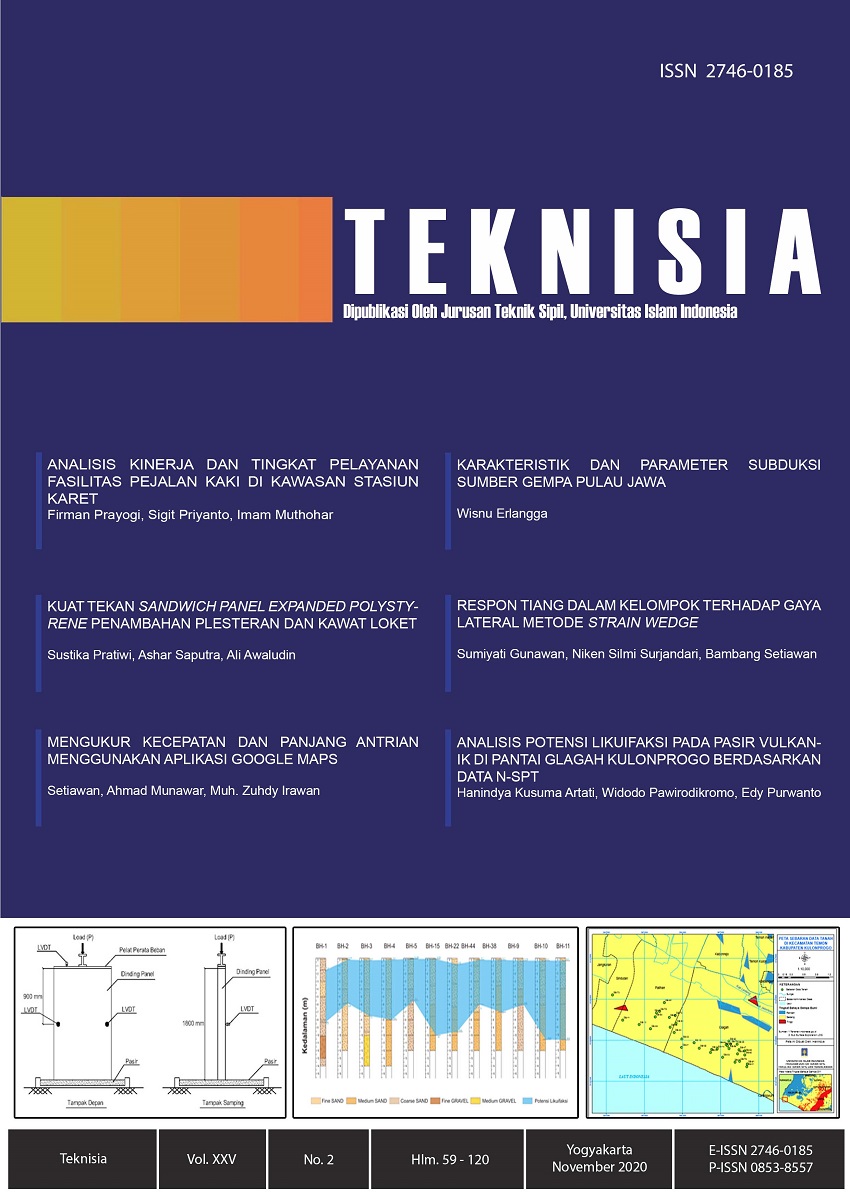Main Article Content
Abstract
Karet Station has an average number of passengers at 12,594 people per day in 2018, has a large potential of pedestrian trip generation. The basic problem experienced by pedestrians at Karet Station is when they (KRL passengers) leave the station, they cannot find a clear pedestrian path to accommodate their movement towards other public transport facilities. As the result, the pedestrians scattered and even crossed the road and stopped the public transportation arbitrarily. This activity causes a high risk of accidents and traffic flow constraints caused by reduced capacity of road section due to public transport activities while waiting, lowering, and raising passengers. The purpose of this research was to analyze the pedestrian lane characteristics, and service level based on technical guidelines and stated preferences of passangers. In this research, the primary data were collected by conducting direct surveys in study area to get characteristics of pedestrian, traffic flow, and passanger perception about pedestrian facilities performance. Analytical results from this study conclude that from technical guidelines approach, there are two sidewalk segments in the Karet Station area which require special attention with the level of service categori at C and E level, and also requires improved pedestrian crossing facilities from zebra cross type to be underpass or pedestrian bridge. Based on stated preferences approach, from the assessment of 24 service attributes, there are 6 attributes of lowest performance services included in quadrant I of Importance Performance Analysis (IPA) matrix which are the main priority that must be resolved immediately.
Keywords
Article Details
Under the following term:
-
Attribution — You must give appropriate credit, provide a link to the license, and indicate if changes were made. You may do so in any reasonable manner, but not in any way that suggests the licensor endorses you or your use.
-
ShareAlike — If you remix, transform, or build upon the material, you must distribute your contributions under the same license as the original.
- No additional restrictions — You may not apply legal terms or technological measures that legally restrict others from doing anything the license permits.
References
- Darus, M. D. (2015). Analisis Tingkat Kepuasan Penumpang Terhadap Kualitas Pelayanan Di Bandar Udara Internasional Kualanamu. Jurnal Ekonomi dan Keuangan, Vol 3, No 6.
- Depertemen Perhubungan . (1997). Keputusan Direktur Jendral Perhubungan Darat: SK.43/AJ 007/DRJD/97 tentang Perekayasaan Fasilitas Pejalan Kaki di Wilayah Kota.
- Hidayatullah, C. J. (2006). Analisis Kepuasan Konsumen Terhadap Kualitas Pelayanan Pada Pengguna Bus Malam Cepat Safari Dharma Raya. Malang: Universitas Brawijaya.
- Kementerian Perhubungan . (2013). Peraturan Direktur Jenderal Perhubungan Darat Nomor: SK.7234/AJ.401/DRDJ/2013 tentang Petunjuk Teknis Perlengkapan Jalan.
- Kementerian PU. (2014). Permen PU No. 03/PRT/M/2014 tentang Pedoman Perencanaan, Penyediaan, dan Pemanfaatan Prasarana dan Sarana Jaringan Pejalan Kaki.
- Martilla J. A. and James J. C. (1977). Importance-Performance Analysis. The Journal of Marketing, Vol. 41(1), hal. 77-79.
- Nurhadi, M. (2004). Perencanaan dan Perancangan Fasilitas Pejalan Kaki (Studi Kasus Kawasan Jalan Kaliurang). Yogyakarta: UGM.
- Richie, A. (2013). Analisis Karakteristik dan Kebutuhan Ruang Parkir, Fasilitas Tempat Henti Angkutan Umum, dan Fasilitas Pejalan Kaki di SMPN 5 Yogyakarta. Yogyakarta: UGM.
- Sembiring, B. (2005). Perencanaan dan Perancangan Fasilitas Pejalan Kaki (Studi Kasus Jalan Malioboro). Yogyakarta: UGM.
- Setiawan, D. (2017). Analisis Pemilihan Moda Transportasi dengan Mempertimbangkan Ability To Pay (ATP) dan Willingness To Pay (WTP) Penumpang Menuju New Yogyakarta International Airport (Studi Kasus: Kereta Api, Kendaraan Umum dan Kendaraan Pribadi). Yogyakarta: Universitas Gadjah Mada.
- Transportation Research Board. (2000). Highway Capacity Manual. Washington, D.C.
- Untermann, R. K. (1984). Accomodating the Pedestrian. New York.
References
Darus, M. D. (2015). Analisis Tingkat Kepuasan Penumpang Terhadap Kualitas Pelayanan Di Bandar Udara Internasional Kualanamu. Jurnal Ekonomi dan Keuangan, Vol 3, No 6.
Depertemen Perhubungan . (1997). Keputusan Direktur Jendral Perhubungan Darat: SK.43/AJ 007/DRJD/97 tentang Perekayasaan Fasilitas Pejalan Kaki di Wilayah Kota.
Hidayatullah, C. J. (2006). Analisis Kepuasan Konsumen Terhadap Kualitas Pelayanan Pada Pengguna Bus Malam Cepat Safari Dharma Raya. Malang: Universitas Brawijaya.
Kementerian Perhubungan . (2013). Peraturan Direktur Jenderal Perhubungan Darat Nomor: SK.7234/AJ.401/DRDJ/2013 tentang Petunjuk Teknis Perlengkapan Jalan.
Kementerian PU. (2014). Permen PU No. 03/PRT/M/2014 tentang Pedoman Perencanaan, Penyediaan, dan Pemanfaatan Prasarana dan Sarana Jaringan Pejalan Kaki.
Martilla J. A. and James J. C. (1977). Importance-Performance Analysis. The Journal of Marketing, Vol. 41(1), hal. 77-79.
Nurhadi, M. (2004). Perencanaan dan Perancangan Fasilitas Pejalan Kaki (Studi Kasus Kawasan Jalan Kaliurang). Yogyakarta: UGM.
Richie, A. (2013). Analisis Karakteristik dan Kebutuhan Ruang Parkir, Fasilitas Tempat Henti Angkutan Umum, dan Fasilitas Pejalan Kaki di SMPN 5 Yogyakarta. Yogyakarta: UGM.
Sembiring, B. (2005). Perencanaan dan Perancangan Fasilitas Pejalan Kaki (Studi Kasus Jalan Malioboro). Yogyakarta: UGM.
Setiawan, D. (2017). Analisis Pemilihan Moda Transportasi dengan Mempertimbangkan Ability To Pay (ATP) dan Willingness To Pay (WTP) Penumpang Menuju New Yogyakarta International Airport (Studi Kasus: Kereta Api, Kendaraan Umum dan Kendaraan Pribadi). Yogyakarta: Universitas Gadjah Mada.
Transportation Research Board. (2000). Highway Capacity Manual. Washington, D.C.
Untermann, R. K. (1984). Accomodating the Pedestrian. New York.
